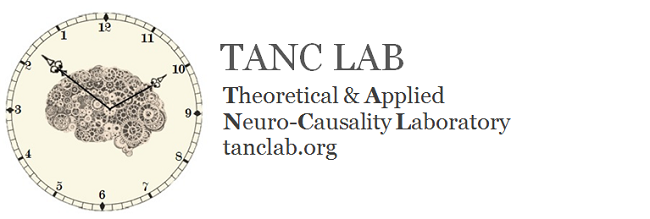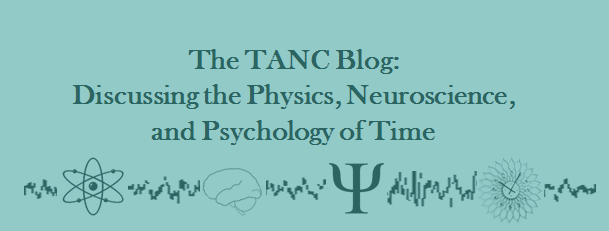
Replication of the Groningen Face Experiment
While we analyze results from the first experiment (light/sound stimuli), we are preparing one of our next projects: a replication of a highly successful EEG presentiment experiment done at University of Groningen (led by Prof. Jacob Jolij and Prof. Dick Bierman). In their experiment a series of static noise images is shown, with one image every 0.1 seconds. Sometimes (randomly), the middle image contains a cartoon smiley face embedded in it. Participants select using right or left mouse buttons whether they think they saw the face or not.
The concept of this experiment is to look for any precognitive markers of the upcoming face in the EEG data. The Groningen researchers reported a precognitive effect when they analyzed data between 0.6 and 0.1 seconds before the face picture appearing.
We’ve started the pilot tests for this experiment. The figure below is an example of some raw pilot test data for the face experiment. The three upper graphs are EEG electrode data showing some alpha wave activity. The bottom graph shows the digital channel in which a long pulse is recorded when a smiley face appears and a short pulse is recorded for the “no-face” condition.
Thousands of times more data will be recorded during the course of the experiment.
The Groningen researchers were able to successfully replicate a precognitive experimental result multiple times (they are still working on their main publication). But in science it is important whether other researchers can also replicate a result. So we will try the face detection experiment at TANC Lab. The University of Groningen team has kindly shared all of their software with us. We have been working on adapting the software to our own hardware. A key part of this experiment is that it runs much faster than our light/sound experiment. Therefore, experimental trials are collected much more quickly so that even if an effect is less powerful there is more data showing it.
The Groningen team has been working on many variations of their core experiment. One of their variations is to study “bilking”. “Bilk” means to trick. In a predictive experiment brain activity is recorded and a prediction is made. But in a bilked situation, the stimulus is changed at the last moment when the subject is (may be?) expecting something else. In the context of precognition bilking is akin to making a temporal paradox. Theorists of quantum mechanics have proposed that if backwards-in-time effects are possible, then the Universe will rearrange itself to prevent a paradox if an experimenter attempts to make one. What is really happening during a bilked experiment? We will pursue this line of research in the future.
Quick update on our experiment: We are nearing completion of our pilot tests and equipment upgrades. We will begin our first formal experiment soon (likely just a few weeks away!). The follow figures are examples of raw EEG data taken from four occipital (back of the head) electrodes and the digital channel, which records an external electronic signal. The digital channel is used to identify stimulus type (light, sound, or null) and duration.
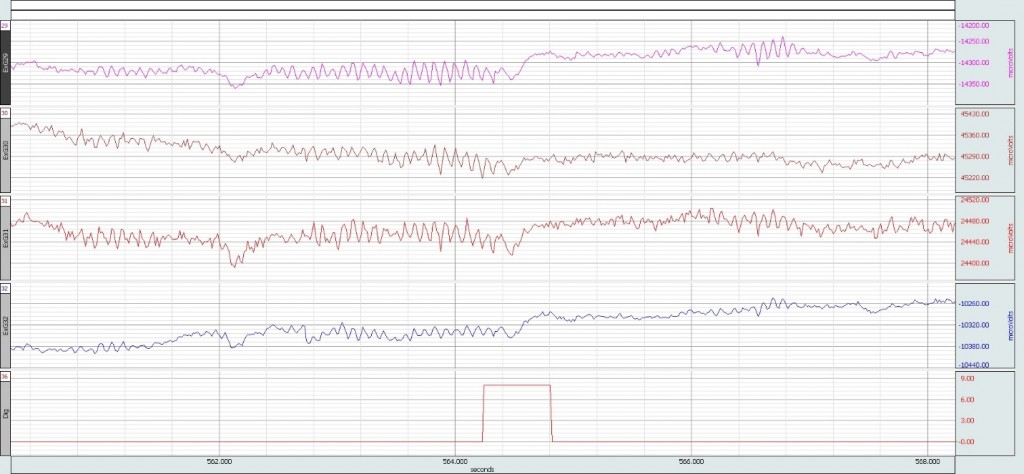
The first figure shows a light flash. The digital channel (bottom row) is hooked up to two miniature solar panels which record the duration of the light flash. We can then look at the data recorded from the electrodes to see any physiological effects.
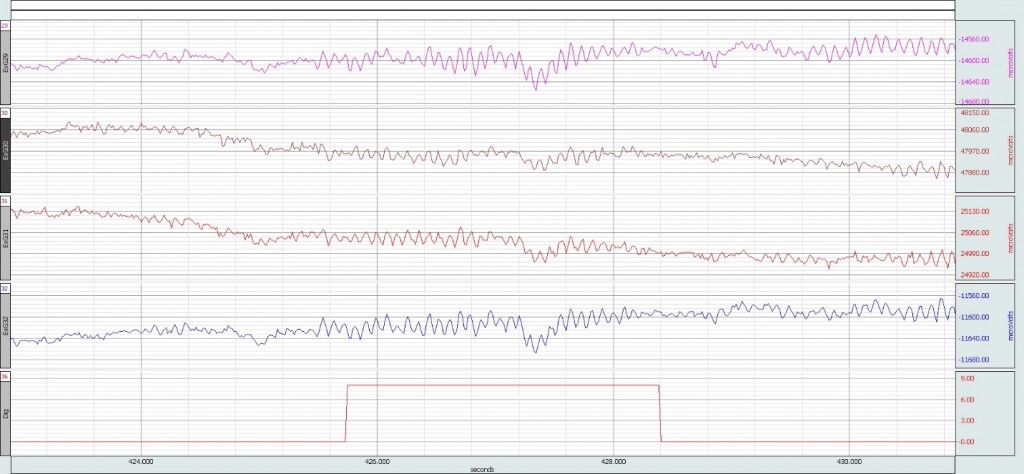
This second figure shows a control trial. The digital channel is sent a longer pulse which tells an analysis program to mark this time region as control data.
Sharon Su
Hello! My name is Sharon Su, and I am extremely excited to be an intern in the TANC lab. My interest in neuroscience stems from a childhood encounter in my aunt’s restaurant. As an obnoxious and curious child, I would often bother customers while they were eating and press them for information about their lives. One particularly rainy day, I met a visiting neuroscientist from Germany and he briefly explained his research to me- of course, in terms that a child could understand. He explained what neurons were, what they did, and how they worked. I was soon reprimanded by my aunt and was left with a thousand unanswered questions. I decided to conduct my own “research” in my elementary school’s library, and gained a simple understanding of the brain.
It wasn’t until middle school that I began my interest in consciousness. A book I had read referenced Descartes’ famous proposition, “I think, therefore I am”, and I looked up supplemental material for it, thus marking my venture into solipsism. Solipsism laid the groundwork for my interests in consciousness, as it created a shift in my conceptualization of incontrovertible certainty. At that point, absolute truth did not exist to me, only relative truth did. I became more and more interested in the idea of subjective experiences, which is how I stumbled upon the concept of qualia and the hard problem of consciousness. Ever since then, I’ve been trying to learn more about the subject. My favorite researcher/author is Christof Koch, whose research deals with neural correlates of consciousness.
Currently, I attend the University of California, Santa Barbara as a second year biopsychology student. In addition to the TANC lab, I am also working in the Simpson Lab, in which I’ve been learning a lot about unsupervised learning and digital signal processing. I’m also in the early stages of pursuing a side project, inspired by Helen Keller, that deals with coding a somatosensory based learning model. As to where I am in my exploration of consciousness and the like, I’m currently reading a lot of arguments for and against the existence of the “hard problem of consciousness”.
I’m thrilled to be a part of the TANC lab, and I hope to aid in their endeavor of making a huge contribution to precognition research!
Hiroumi Kevin Jimbo
Hello, I am an intern research assistant of the TANC Lab. I am a fourth year undergraduate at University of California Sana Barbara studying for a B.S. in biopsychology. Initially I entered UCSB as a psychology major, interested in learning about the vast and still mysterious human mind. At the end of my freshmen year I noticed that there was a limit on what I can learn about psychology itself without some scientific knowledge on the brain. Though the additional four years of science combined with being behind a year meant long nights studying, I changed my major to biopsychology. At the end my better understanding of the brain has led to better understanding of our perception of our world and the mind. It was worth the two years of heavy schoolwork.
I experienced firsthand research as a research assistant for two labs in UCSB. For my sophomore year I took part in the Attention Lab by Professor Barry Gieshbrecht. The research in the lab emphasizes the consequences, control, and classification of selective attention. In his lab, I experienced working with EEG, gaining proficiency with the equipment. In addition, the specific experiment I assisted was done using an fMRI with EEG giving me an extraordinary experience with very expensive, complicating, and exciting equipment.
Right now, I am working as a research assistant in the VIU (Vision and Imaging Understanding) Lab by Professor Miguel P. Eckstein. As a research assistant I have taken part in experiments testing the ability to distinguish a stimulus at different eccentricity, size, and presence of color. I have participated in this lab since March of 2014 and have become acquainted with the usage of eye tracking equipment.
Other than my school work, I have been working hard trying to spread a further understanding of Japanese culture as the President of the Japanese Language Club. Even with the very small Japanese population at UCSB, I am pleased to see that there are people who are interested in Japan and Japanese exchange students willing to teach students about Japanese language and culture.
I am very enthusiastic in being part of a lab working with such an interesting but also contradictory topic. Most people seem to see precognition as a supernatural phenomenon that does not actually exist. I myself did not know about the scientific research done on precognition until seeing the TANC website, opening up a new field of research to me. Though it is not likely that we will find the ability to sense when the next natural disaster is going to happen or anything of that sort, I hope to see advancement in the scientific field of precognition.
TANC Lab has acquired the equipment needed for its first experiment on measuring unconscious precognition via EEG. The system is currently being programmed before the first pilot tests are run. It hopefully won’t be so long before the first data is taken! In the meantime, here is a photo tour of TANC Lab:

Sound isolation booth and control station. We don’t want our experiments interrupted by background noise, so experiment participants will sit inside the sound isolation booth while data is being collected via EEG.

The Mobita EEG system and headsets. A new, advanced 32-channel EEG system will be used to collect data.

This is our rest area so people can relax after exploring the depths of the human mind.
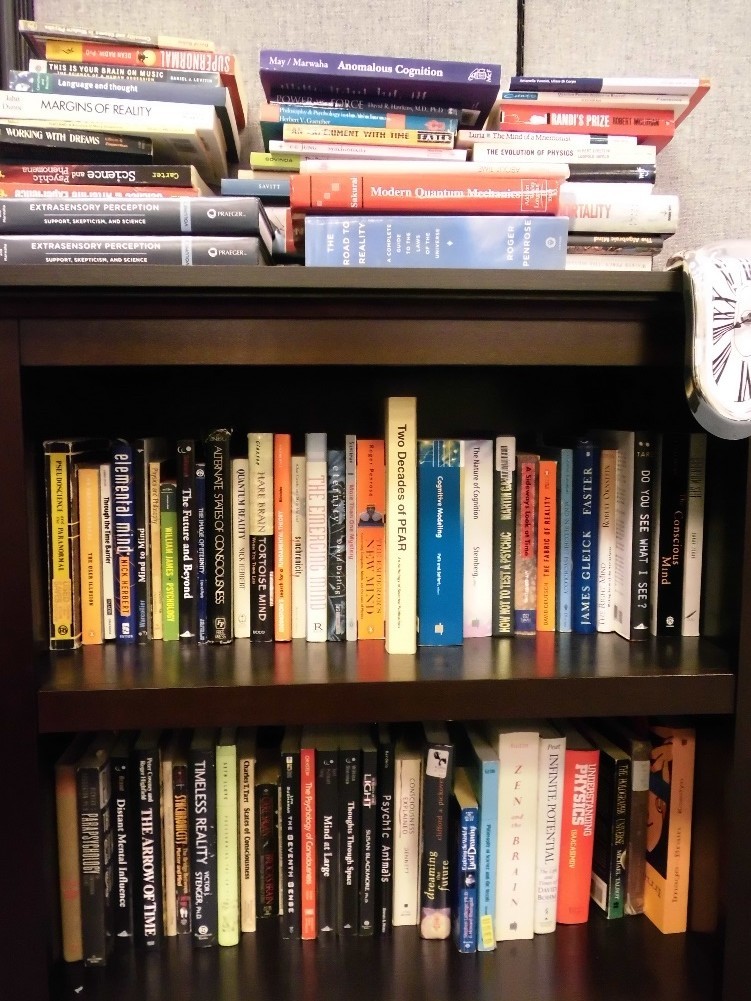 The TANC Lab library has an extensive collection of books on consciousness, psychology, physics, and the nature of time.
The TANC Lab library has an extensive collection of books on consciousness, psychology, physics, and the nature of time.
We will continue to post updates as research progresses. Also, we will be offering a paid internship to do research at TANC Lab. Stay tuned for more updates!
Here we have a guest blog from Michael Duggan who is one of the authors of the meta-analysis of replications of Daryl Bem’s controversial retroactive facilitation experiments http://papers.ssrn.com/sol3/papers.cfm?abstract_id=2423692, and has a long term interest in serious psi research. He is classically trained in the sciences (Ph.D Catalytic chemistry), but it is psi research that truly excites him. Here, he blogs about the controversy surrounding the publication of Daryl Bem’s seminal Feeling The Future Paper in 2011, and the experience of trying to publish a meta analysis of 90 experiments supporting Bem’s earlier findings.
“Feeling the Future” of Bem’s findings
The publication of the paper “Feeling the future: experimental evidence for anomalous retroactive influences on cognition and affect” in the mainstream and highly esteemed Journal of Personality and Social Psychology in 2011 by Daryl Bem (Bem, 2011), professor emeritus at Cornell University, was the academic equivalent of a Big Bang for many scientists and lay persons alike because the heretical message was “precognition is scientifically supported”.
But what did Daryl Bem find really? In a series of nine experiments, he found that in four different tasks, the performance of the participants was related to what happened after their decision was made. For example, he found that participants were able to detect behind which door hid an erotic image approximately 3% above chance level or avoid a negative image nearly 2% above the expected chance level. In another task, defined as retroactive facilitation of recall, participants recalled approximately 2 to 4% more words if they were later repeated several times. In another study, subjects were exposed to a prime after categorizing a picture as pleasant or unpleasant. Bem showed that when the future prime was congruent, i.e., pleasant prime – pleasant picture, the reaction times were faster. It is as if the future can percolate into the present to influence participant’s behavioural responses in these standard but time-reversed psychological tests.
To have an idea of the impact of this paper, it is instructive to take note of the number of times this paper was cited in other scientific journals: 342 times as of 03th July 2015. Furthermore if you search “Feeling the future” with Google you can find approximately two million pages that includes a dedicated page on Wikipedia. Additionally Bem was interviewed by many radio and TV stations, from the Colbert Report to the David Letterman show and Through The Wormhole with Morgan Freeman. Such widespread and generally positive media coverage is unprecendented for any kind of parapsychological type finding. Bem deserves plaudits for breaking new ground in this way.
It is also extremely important to bear in mind that evidence for precognition is not limited to the behavioural studies of Bem and others but extends to presentiment effects in human physiology (Mossbridge, et al, 2012) and forced choice guessing (Honorton and Ferrari, 1989).
This event is quite interesting to observe both from the scientific and sociological point of view. From a scientific point of view, it is curious to note that most other papers related to “parapsychological” stuff published in mainstream journals (e.g. Psychological Bulletin, British Journal of Psychology) did not receive similar “attention” even if they usually referred to telepathy or distant mental interaction. Very probably, precognition is deemed not so “woo” as other parapsychological phenomena. This more favourable attitude to precognition might have something to do with recent serious attention to the idea of retrocausation in quantum mechanics through the work of physicists such as John Cramer and Daniel Sheehan. Indeed, several AAAS (The American Association for the Advancement of Science) symposia have been dedicated to exploring retrocausality from both a physics and parapsychological perspective, inviting contributors from both fields.
As expected, Bem’s paper was analyzed and criticized, in particular by scientists, starting from theoretical grounds progressing into qualms about methodology and statistics, and finally questioning Bem’s interpretation of results. The main theoretical criticisms stand on the premise that “precognition” does not exist and hence all evidence supporting it is surely based on flawed procedures or interpretations. It is clear that this attitude is based on a prejudiced old Newtonian ideology rather than an examination of the state of the debate. As mentioned above, serious scientists are exploring retrocausation with obvious implications for the possibility of precognition. More generally, quantum mechanics with its basis in probability theory, non-locality, and entanglement effects is so strange and counter-intuitive, that outlawing parapsychological phenomena because they contradict the so-called laws-of-physics seems somewhat premature. More interesting, are the criticisms related to methodology and statistics. Initially criticisms of the reviewers and the editor that accepted the paper for publication evolved into an attack on the type of statistics used, a situation inflamed by the fact that 8 out of 9 experiments yielded statistically significant results that were “too good to be true”. Eventually these discussions lead to a more general critique –in some quarters - of how ALL psychology experiments are conducted leading to constructive advice moving forward, for example; specifying a priori which hypotheses are exploratory and which ones are confirmatory, pre-registering the studies in order to reduce so-called questionable research practices (i.e. optional stopping in the data collection; post-hoc selection of only statistically significant comparisons; arbitrary elimination of outliers, etc.), and ultimately including the abandonment of frequentist statistics in favour of Bayesian ones. This last criticism is particularly interesting because the debate, supported by scientific papers, yielded very different results using the same data. For example, Eric-Jan Wagenmakers of the Department of Psychology University of Amsterdam and his colleagues (Wagenmakers, et al.,2011), found weak to nonexistent support when analyzing Bem’s data, whereas a rebuttal by Bem, with two experts in Bayesian statistics (Bem et al., 2011), found strong support. Another independent Bayesian analysis carried out by Jeff Rouder of the Department of Psychological Sciences University of Missouri and Richard Morey of the Rijksuniversiteit in Groningen(Rouder and Morey, 2011), concluded as follows:“There is some evidence, however, for the hypothesis that people can feel the future with emotionally valenced nonerotic stimuli, with a Bayes factor of about 40. Although this value is certainly noteworthy, we believe it is orders of magnitude lower than what is required to overcome appropriate skepticism of ESP”. A Bayes factor of 40 in this case means that Bems’ data are 40 times more likely to have occurred under the hypothesis that “feeling the future” is true than under the hypothesis that it is not true. It is curious to note that for the supporters of the Bayesian approach, a Bayes factor of 30 is considered as strong support to the hypothesis.
This continued enhancement of the criteria of scientific evidence to accept parapsychological phenomena, is quite interesting. For example, as for all other lines of research, a given phenomenon is considered more probable if it is observed by independent replications. In a recent meta-analysis of all experiment related to “feeling the future”, we found 90 studies overall, conducted by Bem and thirty others, that elicited very strong support all of Bem’s original experiments with the exception of the retroactive recall facilitation tasks. However, yet again, this evidence was deemed insufficient by skeptics, in particular by Wagenmakers (Wagenmakers, 2014), in part because most of these experiments were not pre-registered and hence it cannot be excluded that the experiments are contaminated by flawed procedures and statistical analyses. Also, recently, Daniel Lakens has provided a critique based on our assumptions of the file drawer: http://daniellakens.blogspot.nl/2015/04/why-meta-analysis-of-90-precognition.html. We are in the process of providing a robust argument to his conclusions, but it is worth noting that if we were to apply such a stringent approach to existing meta-analyses related to psychological investigations, most would be viewed as suspect.
Final reflections: Though we do not believe there is a file-drawer problem, we are in the process of setting up collaborative pre-registered replications so this criticism will not apply to future experiments.
References
Bem, D. J. (2011). Feeling the future: experimental evidence for anomalous retroactive influences on cognition and affect. Journal of Personality and Social Psychology, 100(3), 407-425.
Bem, D., Utts, J., Johnson, W.O. (2011). Must psychologists change the way they analyze their data?Journal of Personality and Social Psychology, 101(4), 716-719.
Honorton, C., and Ferrari., D. (1989) “Future Telling” A meta-analysis of forced choice precognition experiments, 1935 – 1987.
Journal of Parapsychology, Vol. 53. December 1989.
Mossbridge, J., Tressoldi, P., and Utts, J. (2012) Predictive physiological anticipation preceding seemingly unpredictable stimuli: a meta-analysis.
Frontiers in psychology. 17th October 2012.
Rouder, J. N., & Morey, R. D. (2011). A Bayes factor meta-analysis of Bem’s ESP claim. Psychonomic Bulletin & Review, 18(4), 682-689.
Wagenmakers, E. J., Wetzels, R., Borsboom, D., & van der Maas, H.(2011). Why psychologists must change the way they analyze their data:The case of psi: Comment on Bem (2011). Journal of Personality and Social Psychology, 100, 426–432.

Isn’t the fact that casinos thrive, strong evidence against precognition? This is one of the most frequent questions/comments we hear with regards to our work, so we wanted to use this blog post to answer the question.
The fact that casinos do in fact maintain their edge, does suggest that people cannot consciously, or willfully, gain access to precognitive information in a terribly reliable manner. However, it does not rule out the existence of precognition that manifests more intuitively, or unconsciously. Psychologists have shown that information can exist in our minds that we are not consciously aware of, information that, for whatever reason, does not translate into conscious awareness; yet there are methods psychologists can use to access this information which is hidden from conscious awareness.
Some of the earliest work on this topic was most famously conducted with patient HM, who underwent brain surgery that removed part of the temporal lobe, the hippocampus. After initial post-surgery assessment, doctors saw that HM could carry on coherent conversations and was in fact quite lucid. Yet on further inspection it became very clear that there was something wrong with his memory. He had lost his ability to translate short term memories into long-term memory. For example, after meeting a new person (post-accident) if that person would leave the room and come back, they would have to be re-introduced. Psychologists initially thought that this meant that all new learning would be compromised. Yet researchers found out that certain types of learning and memory remained intact – specifically unconscious, or implicit learning. For example, after many sessions of learning a task like mirror drawing, even though his skills would improve on the task, he would have no awareness of ever doing the task before. Each time he did the task, it would seem to him like it was his first time. This type of amnesia, in which new explicit learning is compromised, is termed anterograde amnesia. The main character in the movie ‘Memento’ is a great example of someone with anterograde amnesia.
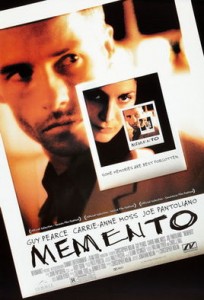
This groundbreaking work not only spawned modern cognitive neuropsychology but helped demonstrate very clearly an important fact about the human mind; the things that we are consciously aware of are only a very small part of the information available that influences our decisions and actions. Perhaps what is most problematic with this is that we tend to treat our conscious perceptions as the whole story, when in fact a bulk of the action takes place outside of our awareness.
When it comes to precognitive information, it is possible that we all might be akin to patient HM (i.e., perhaps suffering from a type of ‘retrocausal amnesia’ – unable to explicitly access this future information). For example, you could tell HM the following day’s winning lottery numbers, but despite this information, as soon as he’s distracted for long enough, the information would be lost to conscious memory. Perhaps we similarly are unable to access unconscious precognitive information. Importantly, psychologists have come up with clever ways to demonstrate the existence of these memory traces even when they cannot be explicitly communicated (e.g., using indirect behavioral and physiological methods).
This is the type of methodology we will be using in our experiments at the TANC lab. For example, instead of asking our participants to tell us what they think is going to happen in the future, we will measure their brain waves and/or reaction times to stimuli and see if it can reveal information about future events. In 2012, Mossbridge and colleagues analyzed all studies from 1978-2010, showing that there is in fact evidence across all studies of physiological pre-arousal that corresponds to randomly chosen future stimuli.
Therefore, the fact that casinos still thrive is not strong evidence against the existence of precognition. Given how compelling it would be to be able to “beat the house” or consistently predict stock market outcomes, our experiments are aimed at using unconscious precognition to predict these types of real-world outcomes. In future blog posts we’ll describe in more detail the TANC experiments- one of which is specifically targeted at using unconscious precognition to win at roulette!
Stay tuned!
Dr. Stephen Baumgart
President
Greetings! I am the founder and president of the TANC Lab. My interest in science dates back to elementary school when I would spend recess in the library, vociferously reading all the books on space travel. Carl Sagan’s TV series and book “Cosmos” inspired me to choose science as a career while in middle school.

I realized I’d need to study hard to achieve this dream; therefore, I slowly improved my math and science ability from below average in middle school, to being one of the top students by the time I entered U.C. Davis as a physics major. It was at U.C. Davis that I was introduced to the possibility of retrocausality. We were taught that no laws of physics prohibited backwards-in-time communication but that there was no experimental evidence for it (which I later found out that this is not strictly true because of precognition research!). Upon graduation from U.C. Davis, I continued studying physics as a graduate student at Yale University, receiving my Ph.D. in 2009.
I’ve always had a broad interest in science, paying attention to cutting-edge research across multiple fields. At Yale, I became interested in the mystery of consciousness and the various debates regarding how subjective experience can arise from brain activity, but no explanation seemed satisfactory to me. It still seems impossible to figure out how to explain subjective experience in terms of current science. I was also interested in neuroscience research which seems to show that conscious awareness of intention lags behind the decision processes that lead to behavior (e.g., the work of Benjamin Libet). The presentiment research we’re working on now will certainly have important implications regarding our notion of “free will”. By developing solid paradigms to study precognition we will be able to make headway on what have seemed largely intractable problems in the philosophy of science.
Meanwhile, I spent most of my time at Yale enduring hard classes like Quantum Field Theory and then doing my dissertation research on high-energy nuclear physics. I worked in the STAR at RHIC collaboration (the acronym stands for “Solenoidal Tracker At the Relativistic Heavy Ion Collider). The RHIC collider would smash gold ions, copper ions, deuterons, or protons together at near the speed of light in order to study the nuclear forces which bind quarks and gluons within nucleons and nucleons within nuclei.
The Relativistic Heavy Ion Collider:
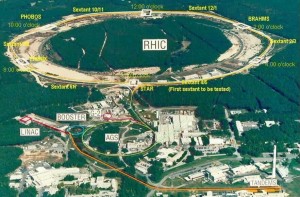
My dissertation research focused on the production of charm quarks in copper on copper collisions. A picture of the STAR detector readout is below:
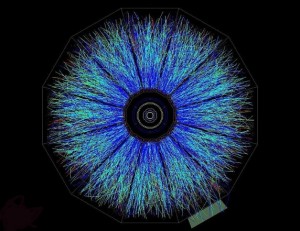
As it turned out, Professor John Cramer, the developer of the Transactional Interpretation of quantum mechanics, was also a member of the STAR collaboration. A key aspect of Transactional Interpretation is that quantum interactions are explained in terms of advanced (backwards-in-time) and retarded (forwards-in-time) waves. I also learned about Prof. Cramer’s work investigating retrocausal communication using quantum optics. He believed it might be possible to communicate backwards in time based on standard quantum mechanics. However, he has found a flaw in his calculations invalidating his current experimental design.
After graduating from Yale, I continued my work in high-energy nuclear physics at the RIKEN Radiation Laboratory in Wako, Japan (just outside Tokyo). I worked in the PHENIX experiment (Pioneering High-Energy Nuclear Interaction eXperiment) on a RIKEN postdoctoral fellowship for three years. I was in Japan during the devastating earthquake, tsunami, and nuclear meltdown in Fukushima. My supervisor went to Fukushima prefecture to do radiation monitoring while I continued data analysis in Wako.
At RIKEN I continued being interested in retrocausality, stumblingly upon Prof. Dick Bierman’s work in unconscious precognition. Reading other papers in the field, the results appeared to be solid and good evidence of retrocausality. This research is important to our understanding of physics, neuroscience, and psychology so precognition research should be prioritized to understand the underlying causes behind this phenomenon.
After my RIKEN fellowship expired, I initially desired to continue an academic career. However, the so-called “two-body problem” would make it extremely risky and difficult to start a family while following a traditional academic career. So instead of being depressed that so few scientists were investigating presentiment and retrocausality, I decided to try it myself! I ran my own informal project copying an experimental design from Dean Radin, but it became apparent that I would need more resources and colleagues in order to do professional-quality work; therefore, I founded the TANC lab. I plan for our lab to undertake pioneering high-quality research into the nature of time and consciousness. Be sure to sign up for our email list and we will keep you posted on all our exciting new discoveries!
Introducing Dr. Michael S. Franklin
Treasurer/Director of Research and Development
I’m thrilled to have this incredible opportunity to be the Director of Research and Development at the TANC lab. Although on one hand, this seems to be the culmination of many years of work on topics related to the brain, consciousness, and cognition (which I will describe below), on the other hand, I’ve been well aware that forming such a lab to investigate controversial aspects of time would be a long-shot. After all, funding for such work is especially difficult to obtain, and my advisors and mentors throughout the years have made it clear how risky such research endeavors are career-wise. Despite these risks, it has been curiosity that has driven me to keep pursuing this work. In this post, I want to give a brief overview of where this curiosity has led me over the past 20 years!
The questions that most interest me are the big ones – for example, how do our minds work? How do minds arise from something physical, like the brain? What are the mind’s capacities? What can learning more about the mind reveal about the nature of the universe and reality in general? As an undergraduate at University of Wisconsin, I decided majoring in psychology and zoology would give me the best foundation to get at these questions. At University of Wisconsin I had some great research experiences, first at the Primate Center, followed by volunteering in a sleep lab at the Psychiatry Department in the Medical School. At the time my main interest within psychology was dreams, lucid dreaming in particular, so it was exciting to get hands-on experience in a sleep lab.
Gearing up for graduation and unsure of my future plans, although tempting as it was to pursue my rock band dreams…
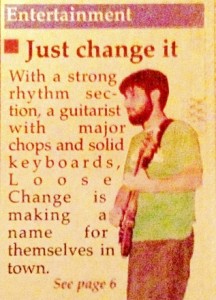
on a whim I sent a note to Stephen LaBerge, who literally wrote the book on lucid dreams, inquiring about an opportunity to work in his lab at Stanford University.
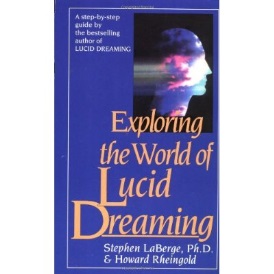
Well, as luck would have it, he invited me out to his lab where I spent about a year studying lucid dreaming – the ability to become aware within the dream that you are dreaming. This was an exciting time, working evenings in the sleep lab with subjects who could reliably have lucid dreams in the laboratory and indicate this with trained eye-movements (the “lucidity signal”). To be able to watch the subjects’ brain waves and eye-movements in real-time from a separate room, and know they are in REM sleep and dreaming, yet see them indicating pre-communicated signals with their eyes was fascinating. It really felt like pioneering work – using the scientific method to explore the bounds of consciousness.
At this same time I was first exposed to experimental parapsychology as a research assistant on a project measuring EEG during a telepathy experiment (a Ganzfeld procedure). After witnessing some intriguing sessions I became more open to the possibility that the current mainstream scientific worldview, which excludes phenomena like telepathy and precognition, may not be the final word on such matters. At this time I began to settle on cognitive neuroscience as a path for trying to understand important questions about consciousness. After all the common phrase of the day was, “the mind is what the brain does”, so why not study the brain to learn more about the mind.
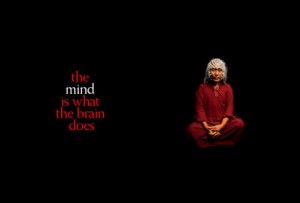
So after spending a year at Stanford, I pursued a master’s degree in psychology at Tulane University, gaining experience in EEG by doing studies on language processing. Then I went to University of Michigan for my doctoral degree, receiving a PhD in cognitive psychology, studying a range of topics on language, memory, and attention. My dissertation project involved work with fMRI, investigating how the brain processes order information. I also had the opportunity to work with trained musicians (this time as a researcher), examining the cognitive benefits of early and extended training in music.
While pursuing this post-graduate work I still maintained an interest in more ‘fringe’ topics, and had an amazing opportunity to do a summer research internship at the Princeton Engineering Anomalies Research Laboratory (PEAR lab) investigating mind-matter interactions. Also, somewhat to my surprise, I had an opportunity to be a teaching assistant for a course at University of Michigan; Psychology of Consciousness. However, this wasn’t a typical college course on consciousness that focused on brain and behavior. Instead, we discussed topics like remote viewing, precognition, and lucid dreaming and read about consciousness from different perspectives (e.g., Ken Wilber – “No Boundary”). At this time I was in touch with Daryl Bem and Dean Radin regarding their work on precognition and realized what little work had actually been done investigating implicit or unconscious precognition using basic cognitive psychology paradigms and methodology that I had been learning about in graduate school (measuring variables like reaction time and error rates). Towards the end of my time at U of M, I began developing and testing out my own basic precognition paradigms. Although this work was understandably treated with skepticism, I was lucky to have found mentors that allowed me the freedom to explore this work; and perhaps much to their surprise, I was finding results that seemed to support the hypothesis of precognition.
As timing would have it, just as I was graduating from U of M in 2008, Dr. Jonathan Schooler was about to move to the University of California, Santa Barbara, and with a 3-year grant to study precognition and other forms ‘anamolous cognition’, he was looking for a post-doc and I was looking for a job. Now it’s been over six years that I have had the privilege of working with Dr. Schooler in the META lab, first as a post-doc and now a project scientist at UCSB in the Department of Psychological and Brain Sciences. At UCSB, I’ve found a great research environment where I’ve been able to continue work on precognition with his support and guidance, and also work on topics related to consciousness and cognition that actually turn out to be quite relevant to the work on precognition; specifically, the role of attention, or more specifically the lack of attention (i.e., mind-wandering) and meta-awareness on task performance. Now with over thirty publications in mainstream journals, and serving as a reviewer for articles, I have a great deal of experience developing and critiquing experimental designs and statistical analyses. I think this in particular has allowed me to create tight experimental protocols and given me a keen eye for difficult to detect confounds which is critical in this kind of work.
So it was extremely exciting to get connected with Dr. Stephen Baumgart this past year, who not only has a similar vision for approaching this work on precognition in an unbiased and rigorous way, but was also willing to put in the seed money for the lab out of his own pocket while we seek outside funding to keep the lab sustainable. As mentioned in our earlier post, headway on this difficult topic will take a concerted effort, and with the TANC lab, we hope to have the opportunity to do just that. By building on the work we have already done, I think we are in a great position to make some real progress on this important topic which has such profound implications.
In future blog posts, I’ll be discussing this earlier work in more detail and my own views on the current controversy in the field. Stay tuned!
Welcome to the TANC lab’s first blog entry! We are excited to be starting this blog where we will be reporting on lab news, discussing the latest research, and answering questions. As a non-profit organization our goal is to share our findings and make these complicated topics in physics, neuroscience, and psychology as accessible as possible; it is your questions and comments that allow us to do this. We encourage comments and hope this blog will lead to a productive dialog.
So, as you have probably figured out by now, at TANC, we are interested in learning more about the nature of time. Why this interest in time? Well, there are still many unanswered questions about time; and perhaps, most fascinatingly, what scientists do know about time conflicts with our everyday experience. One of the reasons why Einstein’s work made such an impression in science and popular culture was that his theory of relativity contradicted our basic intuitions about time. Instead of moving at a constant rate, time is in fact relative and without taking into account these strange “time dilation” effects, current GPS technology would not work! Also, when we see, for example, a picture of a cracked egg, next to picture of an intact egg we can confidently assume that the latter happened first. Yet at the most at the most fundamental, particle level, physicists are unable to detect this directional ‘arrow of time’ making it impossible to discriminate past states from future states. One theory we will be investigating is whether time is in fact symmetrical – flowing both forward and backward.
(Checkout ‘Science of Interstellar’ for a great recent reference on these temporal phenomena discussed in context of the recent movie ‘Interstellar’)
Complementing this work in physics is recent experimental work in psychology that suggests intuitive/unconscious knowledge of unpredictable future events can be detected in human physiology. Cornell psychologist Daryl Bem recently published similar “backwards in time” effects, finding, for example, that studying for a test after it occurs, improves one’s test score! While we acknowledge the controversy surrounding this work and appreciate the need for careful scrutiny, it is in a spirit of scientific curiosity that we do not reject this work out of hand. Instead, we propose that more work is needed (see, for example, our recent opinion piece).
Despite the groundbreaking nature of these claims, should they hold true, resources are almost non-existent to carry out the careful work needed to rigorously examine and evaluate these claims. For example, only a few studies have actually measured brain waves (i.e., EEG) to look for signals corresponding to awareness of future information. The TANC lab is the first lab world-wide dedicated to answering these questions. We will be running lab experiments with EEG, incorporating, for the first time, neurofeedback to see if it is possible to train awareness and increase sensitivity to this future information (for more details check out our informational video). We will also be developing a number of behavioral experiments, in the form of games/apps that test for backward in time effects.
For many years our well-trained, and experienced team of scientists have been working on developing protocols to offer the most compelling proof, should precognition be real – that is, the successful prediction of real world events like outcomes of casino games and stock market fluctuations. With promising pilot results in hand, we are eager to continue this investigation full-time with state-of the art equipment. Importantly, we realize that it is this concerted effort over many years in order to that is needed in order to make progress at answering these important questions about time. As a non-profit organization, we rely largely on donations and therefore need your help in order to make the TANC lab a sustainable research program. We ask that those who are curious about these same questions to please consider making a donation to help support our research effort.
Stay tuned for upcoming blog posts where we will introduce our scientific team, provide updates on the status of the lab, and discuss our research in further detail. Please sign up for our email list to stay up to date on lab news and spread the word! And if you haven’t already, check out our website and facebook page for more information and videos describing our research.
The TANC team






 The TANC Lab library has an extensive collection of books on consciousness, psychology, physics, and the nature of time.
The TANC Lab library has an extensive collection of books on consciousness, psychology, physics, and the nature of time.